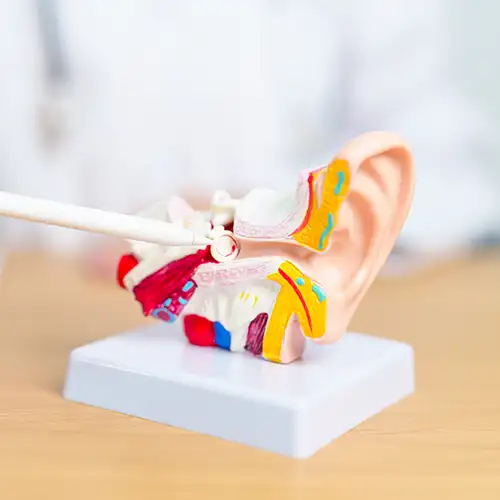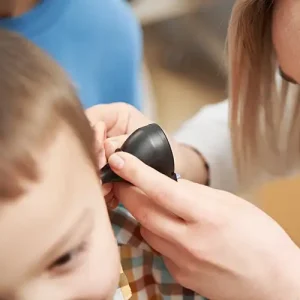Ear infections occur when parts of the ear become inflamed due to bacteria or viruses. While infections can affect the outer ear (otitis externa) or inner ear, middle ear infections are known as acute otitis media. Typically, ear infections often cause ear pain, fever, difficulty sleeping and in some cases, temporary hearing loss.
While many ear infections clear on their own and are short-lived, recurring or untreated infections can lead to complications. These complications may include chronic ear infections and future problems, language development delays in children or long-term hearing loss in both children and adults.
Understanding the symptoms, causes, risk factors, and treatment options is essential for managing ear infections effectively and preventing permanent damage.


Children are likely to experience middle ear infections (otitis media) for several reasons. Their eustachian tubes, which connect the middle ear to the back of the throat, are smaller, more horizontal and prone to becoming blocked.
Common Causes And Risk Factors Include:
The anatomy of a child’s ear is still developing, so even a mild infection can lead to recurrent ear infections, especially if not treated thoroughly or followed up appropriately.
Although children tend to get fewer ear infections as they age, this may not always be the case. If you recognise any symptoms of ear infections in your child, always seek medical advice. If infections are recurring, contact Complete ENT.
Learn more about our Paediatric ENT services.
Recurring ear infections in adults are less common than in children, yet it does occur and can be painful to deal with. In particular, the most common types of ear infections in adults are outer ear infections (otitis externa) and recurrent middle ear infections occur far less commonly.
Common Adult Risk Factors Include:
In adults, infections may be more persistent or indicative of an underlying condition, such as eustachian tube dysfunction or structural abnormalities.
The best care begins before symptoms even appear. By adopting simple strategies, you can greatly reduce your family’s risk of ear infections.
Maintain Health & Hygiene
Encourage everyone in your household to wash their hands thoroughly and regularly. Clean hands help break the cycle of germs that often lead to upper respiratory infections and, in turn, middle ear infections.
Immunisations are one of the simplest preventive tools we have. Ensure that children receive their pneumococcal vaccines and annual flu shots on schedule. Adults should also stay current with recommended vaccines to reduce infections that may spread to the ear.
Adopt Safe Practices For Infants
Breastfeeding, where possible, provides antibodies that support an infant’s immune system and help prevent infections. When feeding, hold your baby somewhat upright rather than lying flat. This posture helps prevent milk from pooling around the eustachian tubes. Some studies have linked extended pacifier use to a higher rate of middle ear infections in babies and toddlers. Support healthy ear‑tube function by avoiding pacifier use or weaning its use early on.
Manage Allergies & Respiratory Health
Allergies and sinus congestion can impair eustachian‑tube function, leading to fluid build-up and infection. Work with your GP or an ENT specialist to control allergy symptoms. Always seek prompt treatment for colds, sinusitis or other respiratory issues.
Second‑hand cigarette smoke is a known risk factor for ear infections in both children and adults. Smoke irritates and inflames the upper airway, making fluid drainage more difficult. Protect your loved ones by enforcing a smoke‑free home and car.
Protect Ears During Water Activities
Water trapped in the ear canal can create the perfect breeding ground for infection. When swimming, consider soft silicone earplugs or a snug‑fitting swim cap. After water exposure, gently dry the outer ear properly with a soft towel. Never insert cotton buds to “dry out” the canal.
Avoid Damaging Your Ear Canal
Avoid inserting cotton buds or other objects into the ear canal. This can push wax deeper and can also irritate or injure the delicate skin of the ear canal, increasing infection risk.

Location: Occurs in the middle ear, the air-filled space behind the eardrum.
Causes: Commonly follows upper respiratory infections, where bacteria or viruses travel through the Eustachian tube to the middle ear.
Symptoms: Ear pain, fever, hearing loss, a feeling of fullness in the ear and, if the eardrum ruptures, sometimes fluid drainage.
Treatment: The infection may resolve on its own, but antibiotics are prescribed in bacterial cases, especially for children, so always visit your GP. Relieve pain with paracetamol and help alleviate discomfort with a warm compress.
The term “glue ear” is a common nickname for otitis media with effusion (OME). This condition involves the accumulation of thick, sticky fluid in the middle ear. The fluid remains in the ear for a long time and can impair the movement of the eardrum and delicate hearing bones (ossicles), leading to hearing difficulties.
OME is particularly prevalent among children, with up to 80% experiencing at least one episode before starting primary school. While it often resolves on its own, persistent cases may require medical intervention, such as the insertion of grommets (ventilation tubes), to drain the fluid and restore normal hearing.
Location: Affects the ear canal, the passage leading from the outer ear to the eardrum.
Causes: Often results from water exposure (hence the nickname “swimmer’s ear”), skin conditions like eczema or from inserting objects into the ear canal.
Symptoms: Ear pain, itching, redness, swelling and sometimes discharge. Pain may worsen when the earlobe is pulled or the tragus (the small cartilage in front of the ear canal) is pressed.
Treatment: Typically involves cleaning the ear canal and administering antibiotic or antifungal ear drops. Keeping the ear dry is crucial during recovery.
Location: Involves the inner ear structures, including the cochlea and vestibular system, which are essential for hearing and balance.
Causes: Often viral, but can also be bacterial. May follow respiratory infections or occur independently.
Symptoms: Sudden onset Vertigo (a spinning sensation), imbalance, nausea, hearing loss and tinnitus (ringing in the ears).
Treatment: Focuses on relieving symptoms. Antiviral or antibiotic medications may be used, along with corticosteroids to reduce inflammation.
The treatment approach depends on the type, severity and the underlying cause of the infection.

It’s essential to seek medical attention if symptoms persist, worsen or are accompanied by high fever, severe ear pain, fluid discharge or hearing loss.
Surgical intervention is sometimes recommended for persistent or recurring ear infections, particularly in children.
Common Procedures Include:
Ear Infection Surgery Is Typically Considered When:
At Complete ENT, we offer a comprehensive assessment to determine if surgical treatment is appropriate and to guide families or adult patients through every step of the decision-making process.


At Complete ENT, our team of Cairns and Brisbane-based ENT specialists are experts in diagnosing and treating ear infections in both children and adults.
We Offer:
Our approach is both thorough and compassionate, helping you or your child find lasting relief and reduce the risk of future complications.

Untreated or recurrent ear infections can lead to several serious complications, some of which may have long-lasting effects on overall health. It’s crucial to address ear infections promptly to prevent the following potential problems.
Persistent inflammation and fluid build-up from chronic or frequent ear infections can damage the delicate structures of the ear, leading to temporary or permanent hearing impairment. In children, this hearing loss can significantly impact speech and language development, hindering their ability to communicate effectively.
In young children, untreated ear infections may result in developmental delays. Hearing loss from chronic infections can affect a child’s ability to develop proper language and communication skills, leading to academic and social challenges. It’s important to seek medical advice for ear infections in order to protect your child’s hearing and development.
If an ear infection is not addressed promptly, the infection can spread to neighbouring tissues and organs. Mastoiditis is the infection of the bone felt directly behind the ear, the mastoid bone. Symptoms include reddened and swollen skin over the mastoid along with the more common symptoms of fever, intense pain and discharge from the ear. If left untreated, mastoiditis can lead to deafness. Occasionally, severe infections spread to the brain and spinal cord, causing meningitis.
Severe ear infections can cause the eardrum to rupture due to the pressure from fluid build-up. An eardrum rupture can be extremely painful and may result in hearing loss. While the eardrum typically heals on its own, repeated ruptures can lead to permanent damage and complications. Complete ENT offers myringoplasty surgery to repair a perforation in the eardrum that was caused by infections, or trauma.
Recurring ear infections may create a mass of skin cells in the middle ear called a cholesteatoma. If left untreated, this growth can damage many of the structures within the ear, including the bones of the hearing mechanism and the bone between the ear and brain.
In some cases, infections can damage the inner hair cells of the cochlea or the auditory nerve fibres themselves. This damage disrupts the transmission of sound signals to the brain, leading to a condition known as auditory neuropathy. Individuals with this condition may have normal hearing sensitivity but struggle to understand speech, especially in noisy environments.
If you or your child is struggling with painful or frequent infections, don’t wait for it to heal on its own. Early assessment and expert care can prevent long-term hearing or developmental issues.
Book a consultation with the experienced team at Complete ENT in Brisbane or Cairns and take the first step toward a clear diagnosis, effective treatment, and peace of mind.


Call us on
07 3905 5999